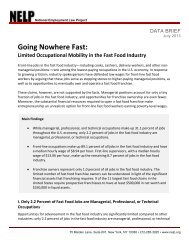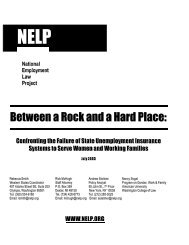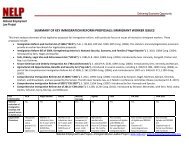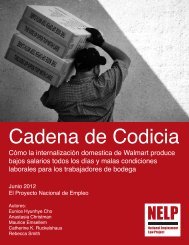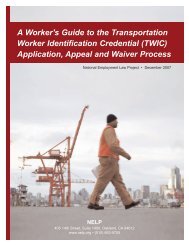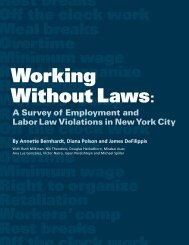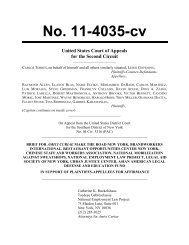Chain of Greed
Chain of Greed
Chain of Greed
- No tags were found...
Create successful ePaper yourself
Turn your PDF publications into a flip-book with our unique Google optimized e-Paper software.
(i.e., the denial <strong>of</strong> wages they hadearned), and more than one in tenhad been injured while working in adistribution facility. 68A study <strong>of</strong> warehouse work in theInland Empire found that the concentration<strong>of</strong> logistics facilities therehad nurtured a fast-growing industry<strong>of</strong> warehouse temporary agencies. In1990 there were 119 such agencies inthe Inland Empire, but by 2008, thenumber had grown to 424 establishments.As a result, the region has ahigher concentration <strong>of</strong> temporaryemployment than any other in thestate. 68Holding DownCosts, EnablingAbuse:Outsourcing’sDownwardPressureIn some cases, subcontracted logisticsworkers themselves are able to see adirect causal relationship betweenWalmart’s ceaseless demands forlower prices and their working conditions.Workers at the Mira Loma SchneiderLogistics distribution center have nodifficulty establishing a direct connectionto Walmart. As recent courtdocuments filed by plaintiffs specify,the only goods loaded and unloadedat the facility are those destined forWalmart stores. Walmart securityguards maintain a constant presenceat the warehouses. Walmart staff frequentlycommunicate directly withRogers-Premier and Impact Logisticsemployees, providing instructionson staffing levels, productivity,and worker misconduct. Contractsbetween Schneider and its subcontractors,Rogers-Premier and ImpactLogistics require that workers receiveorientation materials that complywith Walmart policies. Walmart haseven created a multiple choice testfor Rogers-Premier and Impact Logisticsto administer in order to ensurethat warehouse workers are properlytrained. And when worker productivityhas declined at the warehouse operations,Walmart has cut compensationto Schneider. 70Workers at Schneider Logistics havereported extensive workplace abusesresulting from cost-cutting. In October2011, warehouse workers at theMira Loma Schneider Logistics distributioncenter filed suit in federal courtto protest their working conditions. 71Workers sued Schneider Logistics, aswell as Rogers-Premier and ImpactLogistics, two temporary staffingagencies Schneider subcontracts withto supply workers, alleging violations<strong>of</strong> basic labor protections.Court documents from the case, aswell as recent investigations by theCalifornia Labor Commissioner andthe California Division <strong>of</strong> OccupationalSafety and Health (Cal/OSHA),reveal the breadth <strong>of</strong> labor abuses takingplace in these warehouses.Illegal Pay System. In February2010, Schneider Logistics and temporarystaffing agencies at the MiraLoma Logistics distribution centerinstituted a new “piece rate” system.Under this “piece rate” system, workersreceived pay only for shipping containersor trailers that were completelyfilled or unloaded by the end <strong>of</strong> ashift, resulting in rampant minimumwage and overtime violations. Workersreceived no pay at all for otherwork performed, including sweepingfloors, stacking and breaking down12pallets, unloading partial or overloadedtruck containers, filling orders,attending meetings, or waiting for anassignment at the warehouse, in violation<strong>of</strong> California law.As court documents note, the subcontractingsystem made it virtuallyimpossible for temporary staffingcompanies like Rogers-Premierand Impact Logistics to pay workerslegally-required wages for work performed.Wage statements revealedthat Schneider paid temporary staffingcompanies approximately $150for every fully loaded trailer. Afterdeducting 30% <strong>of</strong> the fee for its ownuse, only 70%, or about $105 was leftto pay workers their wages. Loadinga trailer requires at least two workersfor at least 4.5 to 7 hours per truck,leaving little money left over to payfor other work performed or for legallymandated overtime pay.Lengthy Hours, No Overtime Pay.Since at least February 2010, whenSchneider Logistics implemented thepiece rate system, warehouse workershave endured lengthy hours forweeks upon end without overtimepay. Workers reported that they <strong>of</strong>tenworked shifts up to 12 hours duringa day. One individual reported havingworked for 28 days, each with morethan eight hours a day, and sometimesmore than 16 hours per day, without asingle day <strong>of</strong>f.Illegal and Falsified Records. BeforeWalmart contractors institutedthe “piece rate” system, workers hadused a punch clock to log into workand had been paid on an hourly rate.However, after temporary staffingagencies Rogers-Premier and ImpactLogistics instituted the new piece ratepay system, warehouse workers wererequired to sign in on a blank form,and instructed not to enter other information,such as start or end time,or any break time on the form. AsEverardo Carillo, a warehouse work-





